Back to: Table of Contents | Chapter 1. The Beginnings
The story of construction of the Raleigh Little Theatre building is a blend of bureaucratic bungling, deliberate obstructionism by government functionaries and the tenacity of one woman, Cantey Venable Sutton.
Mrs. Sutton, who died in 1983, was the epitome of the finest qualities of the Southern lady. Of a fine family dedicated to public service (her father served as president of the University of North Carolina), well-educated, married to Louis V Sutton, top executive of Carolina Power & Light Company, Mrs. Sutton was herself a talented actress and singer and had appeared in several opera productions in which the Little Theatre played a part. More important, she was passionately devoted to the cause of theatre in general and the Raleigh Little Theatre in particular.
Source materials on the battle to get the theatre building are difficult to come by since much of the maneuvering and in-fighting went on behind the scenes. One of the most complete accounts was prepared by an unknown Little Theatre member. Originally intended as a story to be entered in a national competition to recognize worthwhile civic activities, the account was never completed for the contest because of a lack of time and the scope of the material to be covered. The history of the building project was later finished and placed in the files of the City of Raleigh and the Raleigh Little Theatre.
The author quite properly observes that the account of the building project reads “like a fiction serial of a daily paper–villain and all.”
The dream of a permanent building for the Raleigh Little Theatre probably goes back to the time when the first two stagestruck Raleighites got together and said something to the effect of, “Let’s give a show,” But the coordinated drive for a building can be dated to a morning early in March 1938 when Mrs. Sutton got together with Ann Preston Bridgers, playwright and theatre sponsor, and Heath Long, RLT president, and the idea of a theatre building as a WPA project first surfaced. The WPA was one of the numerous New Deal agencies developed by the administration of President Franklin D. Roosevelt to fight the effects of the Great Depression.
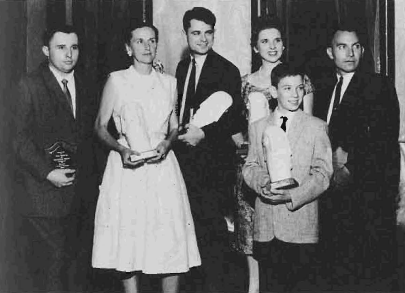
1960 performance award winners with “OSCARS” renamed “CANTEYS” in 1975-76 in honor of Cantey Sutton
A diary kept by Mrs. Sutton fills in some of the details of what happened next.
The support of Raleigh Mayor George Iseley was quickly enlisted, and he designated the site of the old State Fair race track on Pogue Street as the site for the building. He later gave his consent to use of more land for a larger project that would also include an amphitheatre. The larger project, because it would require more labor, and hence put more unemployed men to work, offered better prospects of federal government approval and funding.
In April 1938, an initial campaign for sponsor funds was launched, but only $2,000 was raised. Concealing their lack of funds, Mrs. Sutton and her building committee–Heath Long, Ann Bridgers, Betty Rose Thomas, Mary Dillon, Mabel Starbuck, Thad Hurd, and Vass Shepherd–held on to their dreams.
As a previous RLT historian put it: “With cheerful smile and unbounded belief in the success of the project, Mrs. Sutton gave up most of her personal interests for two years and pitted her woman’s brains and instinct against community distrust of anything built by the WPA and the seemingly endless, insurmountable obstacles that appeared. With the aid of her committee, WPA red tape and ineffectiveness were combated, and city officials finally won over from their good humored disbelief in this Drama Center Project–which they rather expected to fall through and a city playground become heir to the grounds,”
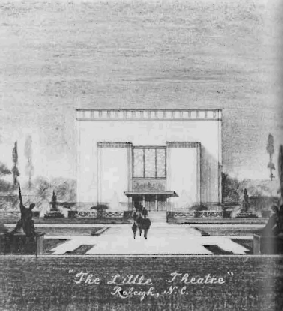
Initial architectural sketch of RLT
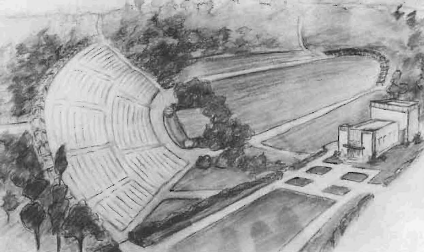
Architect’s sketch of RLT on the grounds of the old State Fair race track ravine
Mrs. Sutton and her committee had valuable allies in their battle. C.L. Barnhardt, the city engineer, was always available for advice and practical help; architect Thad Hurd offered his services, as did Arnold Peterson, planting supervisor; Prof. Roy Keever of then State College advised on electrical layout; and additional members joined the building committee to assist with the effort–Mrs. Clyde R. Hoey (wife of the governor and US senator), Frances Douglas, Charlie Hazell and Arthur Phillips.
As for fund-raising, Mrs. Sutton and company worked a kind of theatrical version of the miracle of the loaves and fishes. The meager starting fund of $2,000 was built up to $6,000 by the committee and an additional $20,000 was raised in the form of cash, gifts of building materials such as lumber, stone, brick, millwork and fixtures, and contributions of skilled services. Altogether, more than $30,000 was raised in sponsor funds against a contribution by the WPA of $23,885 in materials and $86,000 in labor.
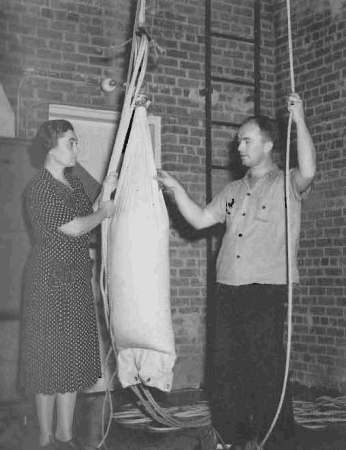
J.L. Farris displays sand bag used for weighting scenery to Ann Preston Bridgers
The RLT report on the project commented: “Part of this epic of courage and determination is shown in these figures, but by far the larger portion lies in the continued efforts necessary for combating the real perils and pitfalls in the way of this unique adventure.”
Some of the earliest objections to the theatre building project came from adjacent property owners who feared their property values were threatened. Their protests were aired at an open meeting of the Raleigh City Council and rejected after what was described as “spirited debate.”
A footnote to the episode: The News and Observer reported on June 29, 1940, on the effect of RLT’s building on nearby property in these words, “When the Raleigh Little Theatre, city officials and the WPA got together to transform the old race track property out in Fairmont into a landscaped amphitheatre and theatre development, adjoining property owners started a hue and cry about not wanting their property values jeopardized. Despite their objections, the project went through at a cost of nearly $150,000.
“Suggesting that the development enhances rather than harms property value, a real estate company put a six-inch ad in this paper several days ago to advertise ‘Beautiful homesites on a high ridge overlooking State College, Meredith College, Raleigh Little Theatre, (and) miles of beautiful natural country scenery’.”
After the meeting with property owners, Mayor Iseley and other city officials gave their consent to the project but said they would accept no financial responsibility for the venture beyond providing the land and drainage, engineering services, and use of city equipment when feasible. A year later a new City Council took office, which like its predecessor was friendly to the project but cautious in making commitments of support. As time went on, however, the new mayor, Graham Andrews, and council members gave their support whenever possible.
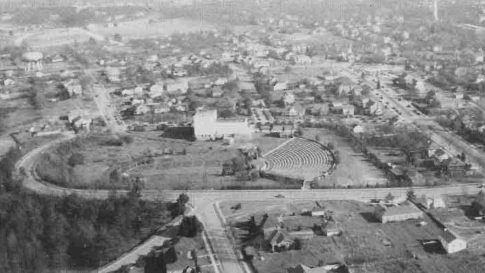
Early aerial view of RLT and surrounding area
Gradually, as the sprawling amphitheatre with its graceful lines and large stage began to take shape, enthusiasm developed among city officials and ordinary citizens. Gifts of shrubs came from individuals and clubs throughout the state, but. except for a handful of Little Theatre members, few thought completion of a theatre building was of overriding importance.
“And in particular were the WPA officials uninterested in a theatre building,” the RLT report says. “Lured into assisting the project through Washington in August 1938 by the large amount of labor involved in landscaping, which could be done during the hard winter months to come, and candidly afraid of the responsibility of building a theatre building with incompetent WPA labor, they had hoped all along to wear down the building committee–through the very inadequacy of that labor and the holding out of government materials–until the harassed committee members would yield up the building venture.
“… From Mrs. Sutton’s diary you see day-by-day details of the dragging of WPA work from the very beginning, incompetency and gruffness of overseers, slipshod methods, small amounts of government materials ordered with frequent delays, peremptory commands for sponsor materials and services.
“Almost at any moment the slovenly work of laborers stopped on small pretext. Demands for extra trucks, for outside dirt for fills, were met by the chairman’s obtaining old trucks for city use from the State Highway Department and permission for the dragging of dirt from neighboring property owners.”
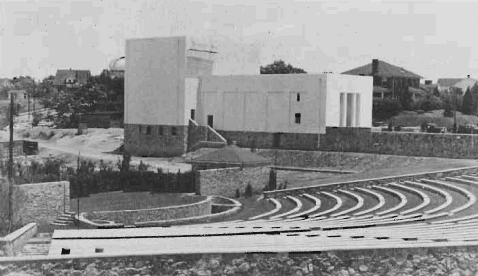
The amphitheatre and nearly completed theatre in 1940.
Still another hurdle arose December 18, 1938, when William Henley Dietrick, architect, found that he was too busy to complete his preliminary sketches for the building which had been filed with the WPA.
A hurried committee meeting was held and it was agreed that a committee member, Thad Hurd, would complete sketches for the building with Mrs. Sutton personally providing necessary help in drafting services. Contractor AJ Fox agreed to approve Hurd’s drawings when they were completed and make a materials list for the project so all necessary documents could be submitted to the WPA in Washington for approval.
Meanwhile, landscaping and grading for the amphitheatre had been progressing, although never with a full complement of laborers. The city had completed its drainage work and engineering survey as promised. In January 1939, after Hurd had drawn plans for the building’s basement, which the WPA had said was necessary before excavation could start, it became obvious that the local WPA supervisor was going to do all in his power to block construction of the theatre building.

Thad Hurd’s approved design for RLT
There were frequent, discouraging meetings with WPA officials up to the state level, and although plans had been scaled down and simplified, there wasn’t enough money available. WPA officials urged Little Theatre leaders to “give up the building and just have an outdoor theatre finished off beautifully.”
Undaunted, the building committee took its materials list back to the office of city engineer Barnhardt, where it was gone over by Mrs. Sutton, Vass Shepherd, Hurd and Willie York, and cut back at all conceivable places. Committee members assumed responsibility for raising the extra money and made plans to seek building materials at cost or as outright gifts from Raleigh businesses.
On April 2, 1939, the completed plans and revised materials list were sent to the district WPA office in Durham, where they languished for weeks.
Meantime, the stone being provided by the city for seats in the amphitheatre was running low, and Vass Shepherd helped Barnhardt arrange for stone from a new quarry on county property.
On April 5, Mrs. Sutton was informed that not all the needed estimates had been prepared. She gathered proof that the estimates had indeed been submitted and obtained a promise that the amphitheatre would be finished by June 12, in time for the opera “Martha” to be performed there to raise money.
Mrs. Sutton also learned that actual spending on the project by the WPA had totaled only $1,200 to this time. The figure was important because just a few days later a WPA official in Durham, James Coleman Jr., declared that already $6,000 of the WPA’s $19,000 allocated for materials had been spent He said that since RLT had inadequate funds, Hurd’s drawings had been tabled along with the specifications and materials list prepared by Barnhardt
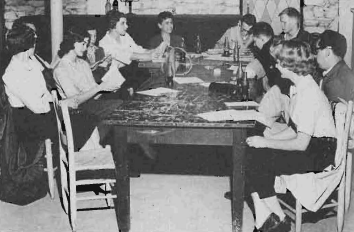
Reading rehearsal in the basement of RLT
The RLT report describes what happened next:
“In indignation at this autocratic distortion of figures, Mrs. Sutton assured Coleman that she would take his inaccurate statement immediately to the newly appointed state WPA administrator, Mr. C.C. McGinnis, that he (McGinnis), as chief engineer, had worked over the project originally and had been instrumental in getting it accepted by Washington, and had been a staunch friend through its early days.
“Coleman immediately changed his tone, admitted a possible error in his statement, and asked to be given time to get the project in shape for presentation to the state office.
“Two weeks later a telephone call from the office of Mr. McGinnis was received by Mrs. Sutton. Upon asking if she should get her committee to accompany her, she was requested to come alone! Upon reaching the office she found awaiting her there several officials of the WPA–and Coleman with the papers!
“She asked that she be allowed to call Barnhardt or Vass Shepherd into the conference, but the request was refused ‘for lack of time.’: Then a mass of papers were thrust into her hands and she was told that the building estimates were so high that she could see for herself that the Little Theatre and the City of Raleigh could not supply sufficient sponsor funds (and) that she should give up the theatre building and let the government finish the outdoor part of the project. Familiar words!
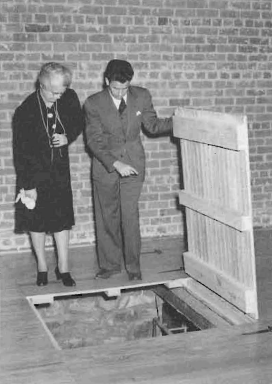
Thad Hurd shows May E. Campbell the new trap door in RLT’s stage floor
“In desperation, Mrs. Sutton asked to be shown this new material list as worked up by Coleman, and, knowing the other by heart–after the days of cutting it down with Barnhardt–she was able to show them certain salient mistakes, gross miscalculations and additions made by Coleman in this new list. She insisted that these be corrected and certain items be switched–which she considered would be more easily obtained by her committee–to the sponsor list.
“Mr. McGinnis, good-humoredly, asked the chief engineer Mr. Bobbitt to make these corrections and bring the corrected list back in to Mrs. Sutton. This was done with the result that the sponsor contribution was lowered by $5,000–with, of course, the government material outlay remaining at the accepted figure of $19,200 for the whole project.
“They laughingly remarked that it had been ‘a good morning’s work for the Little Theatre!’ ”
Numerous meetings of WPA and Little Theatre officials followed as the budget was trimmed to the bone. Despite those efforts, it had become apparent by the fall of 1939 that somebody was delaying the project. The somebody was identified as James Coleman Jr., who had been named supervisor of RLT construction by the WPA.
RLT’s earlier historian was blunt in his judgment: “Mr. Coleman was not only thoroughly untrained and incompetent, but was also definitely malicious as regarding the welfare of the project. He deliberately delayed government material orders of cement and sand.”
Numerous efforts were made to work out some kind of compromise, but the situation worsened. Finally, on October 14, 1939, all concerned met in what was to be a showdown on the fate of the RLT project.
At the meeting, Mayor Andrews and city engineer Barnhardt represented the city; the WPA had four representatives, including Coleman; and the Little Theatre had on hand Vass Shepherd, Mrs. Gordon Thomas and Mrs. Sutton.
“The attempt was made for the third time by WPA officials to produce a mass of figures, proving to the sponsors that the building–if put up–could not be completed with existing moneys,” said the RLT report.
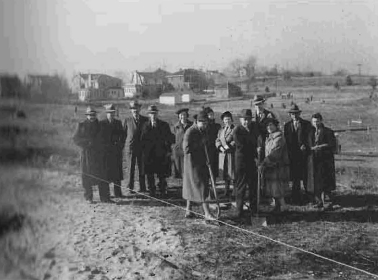
Heath Long, Mayor George A. Iseley and Mrs. Louis V. Sutton break ground for new drama center (1939)
“…The mayor backed up the theatre committee (later describing Coleman as most insulting in manner and downright inefficient), so the WPA officials decided to agree to ‘putting the building under cover’ and then asking for a continuance project if necessary.”
From that time on, Sam Ferebee, “the unlettered but capable and willing WPA foreman,” and his men began to make substantial progress on the Little Theatre building.
Coleman, however, continued to throw up roadblocks. There was, for example, a month’s delay encountered by the brick mason because Coleman delayed an order for brick sand. Again, when a hoist was needed for construction of the upper parts of the building, Mrs. Sutton found suitable equipment. Coleman declared it unsafe but was overridden by safety engineers, and work resumed.
“Mr. Percy Bloxham, county supervisor for the WPA, proved most kindly and tried to keep Coleman from interfering further, but this malicious youngster of 23, from his position in the Durham WPA area office, delayed orders there, heckled Mr. Ferebee and tried to get both Ferebee and Bloxham removed,” the RLT report says. “Notified again of his behavior and his actual insolence to Mrs. Sutton, WPA affirmed that they had now given orders for him not to go near the project!”
In January 1940, Bloxham and Barnhardt began working up the proposal for a continuance project–an extension of the WPA effort. After the proposal languished two weeks–untouched–in the Durham area office, Mrs. Sutton decided something needed to be done. On a trip to Washington she enlisted the help of Mrs. Ellen Woodward, assistant to Harry Hopkins, a top figure in the Roosevelt administration, and U.S. Rep. Harold D. Cooley of North Carolina.

From left to right Mrs. Louis V Sutton, R.J Pearce, Thad Hurd and Mrs. Gordon Thomas view RLT under construction.
Yet another problem arose in February when Mrs. Sutton talked to Coleman about some personal telephone calls he had charged to the Little Theatre’s phone. During the conversation Mrs. Sutton discovered that Coleman was behind the delay in forwarding the continuance project to Washington. Mrs. Sutton again threw herself into the battle, cajoled and threatened the appropriate officials, and on February 14, Valentine’s Day, the project finally was sent to Washington.
Meantime, the money set aside by the WPA to hire workers for the theatre project was rapidly being exhausted, and Ferebee was afraid that if he had to shut the project down until more money came in, he would lose all his skilled men. Another problem developed when Bloxham, who had been friendly to RLT, accepted a job as business manager of Roxboro and left the WPA.
Mrs. Sutton then called Congressman Cooley in Washington and asked him the status of the project. He promised to check and on March 8 sent her a telegram reporting that the WPA was still waiting for full details of the project.
On March 10, Cooley was in Raleigh and discussed the theatre project with Mrs. Sutton, promising to keep after WPA officials until money was approved to finish the building.
Meantime, the brick masons had finished their work on the theatre, and an effort was made to remove Ferebee as foreman and send him to another job. A Mr. Summerville, who had replaced Bloxham, reported that only $500 was left in WPA money for labor.
Then–like the cavalry coming over the hill just in time to save the wagon train–Mrs. Sutton and Mayor Graham Andrews redoubled their efforts, and on March 14, Cooley wired from Washington that the continuance project had–at long last–been approved.
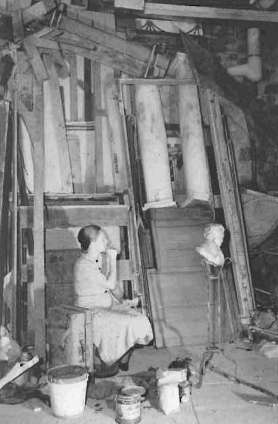
Margaret Darst at work in the scene shop in the basement of RLT (1940).
On March 25, the new project went into operation, and Ferebee attempted to get the needed carpenters and semi-skilled workmen. Summerville–“complete tool of the unfriendly Durham office,” according to the RLT report–sent in the “maim, the halt and the blind” from other projects.
In some way, however, Ferebee outwitted the rules and regulations and got together enough men to resume work on flooring and the roof of the building.
About this time, Arnold Peterson, a landscape architect, was employed by the city of Raleigh. Many shrubs were donated to the Raleigh Little Theatre project by garden clubs, nurseries and individuals. The formal garden in front of the theatre building was graded, and trees given by the Raleigh Garden Club were planted, along with many bulbs and shrubs.
The entire episode of pushing approval of the continuance project through the bureaucracy had one positive result: it clarified ownership of the theatre. During the controversy, the WPA in Washington had asked who would own the theatre when it was completed. Mrs. Sutton and Mayor Andrews met and decided that someone seemed determined to block the project, and it would be best for the city to claim all the assets of the joint venture and be the sole sponsor for the continuance project. The mayor promised complete cooperation in the Little Theatre’s eventual use of the finished building.
During May 1940, just as work was started on installation of the heating and plumbing equipment, architect Thad Hurd was sent to Detroit for a protracted stay to supervise a project there. Foreman Ferebee and engineer Barnhardt worked with the RLT committee, however, solving such problems as a switch to a steam and blower heating system.
The amphitheatre had been completed for some months with the exception of the entrances. The WPA gave its permission to put up a refreshment building for the amphitheatre–if Ferebee could find the men and materials in his skimpy budget.
“It really appeared,” said the RLT report, “as if they (WPA officials) were, through wasting of labor, high overhead charges and slow delivery of materials, attempting to make the WPA labor and material money run out so that the Little Theatre and city would have to finish up the project at high expense at the end.
“As an instance of this, many changes were always being suggested–doing over of existing rock walls, excavation, etc.”
Fortunately, many people from the community stepped forward at this time to push the project to completion. Prof. Roy Keever of State College and Charlie Hazell, a building committee member, worked up the electrical layouts, and equipment was contributed by local firms. Carolina Power & Light Company donated globes and standard tops for the amphitheatre, Westinghouse Electrical Supply Company gave fixtures for the auditorium, while General Electric Company contributed lighting equipment for the lobby, lounge and front entrance, and Thompson Electric supplied fixtures for work areas and dressing rooms. The city provided an electrician to oversee the installation and wiring of the fixtures.
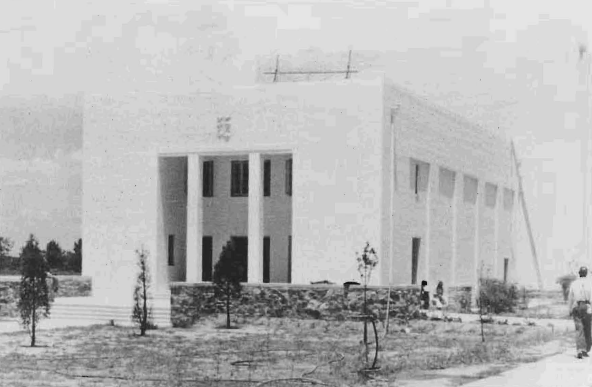
Work nears completion on new building prior to dedication ceremonies in September 1940
The main stone work–with its demand for concrete and sand–was now complete and steel and millwork had been procured, so the WPA agreed to buy much of the lumber and hardware that originally had been earmarked as sponsors’ contributions. This saved Mrs. Sutton and her committee much anxiety, All during the time the theatre was under construction, they had been trying to augment the original $2,000 contribution by finding $25 sponsors. The sum had grown to $4,000, but that was far short of what was needed.
“Mrs. Dale Starbuck had been especially faithful in helping the chairman get these gifts of money and also material, keeping an unflagging interest from the beginning of the project until its end,” the RLT report said. “Mrs. Clyde R. Hoey, the governor’s wife, also lent her cheery advice and interest, and Mrs. Grover Dillon did a lot of work in obtaining gifts of shrubs and plants for the sunken gardens.”
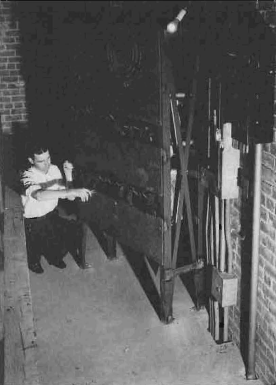
First lighting board mounted on the pin rail
Near the end of May 1940, Ferebee, loyal friend of the Little Theatre and on-site overseer of the project, complained of being “worried to death by the harassments caused by the Durham office.” He told Mrs. Sutton he was getting high blood pressure from his inability to finish the building. He also reported that money was running out because of unusually high overhead.
Mrs. Sutton investigated his complaints and found that the time of various employees not even working on the Little Theatre was being charged to the project. She also found that orders for lumber and other materials had been delayed more than a month.
On May 23, Ferebee was taken violently ill. Mrs. Sutton was “so perturbed and indignant that she went straight to Administrator McGinnis’ office with the news of how this valuable man was being hectored and worried to death. Mr. McGinnis listened with concern as he had once stated to her that Ferebee was the only capable man to entrust with the building of the theatre! Calling in his clerk with the theatre files and Mr McGeady–who happened to be in the office–he found that Mrs. Sutton’s information about overhead and delays was absolutely true. Mr. McGeady tried to refute this but failed, and Mr McGinnis promised Mrs. Sutton an immediate change of personnel in handling the theatre project until its close.”
After a two-week visit in New York, Mrs. Sutton returned in late June to find all orders being given through Bobbitt’s office. Work was progressing on the building, but still more problems had arisen.
Almost all the WPA money for materials had been used, leaving only $300. Bobbitt wanted to know how the RLT committee wanted the last money spent, for seats or other furnishings. After conferring with Little Theatre officials, it was decided to ask the WPA to use the money for the cyclorama and proscenium curtain, which was done.
In mid-August, WPA workmen were withdrawn from the building and, after some minor work on lighting in the amphitheatre, the project was deemed complete.
On September 1, Mrs. Sutton returned from a month at the beach to find that the WPA had departed without finishing the floors in the theatre building. The money had been used up so the workmen just left. A small amount of money was left in the RLT building committee treasury, so Mrs. Sutton drove to Apex and bought floor paint and wax at cost from the Apex Chemical Company; it was applied by a local floor finisher. Six Raleigh stores contributed furniture for the upstairs lounge, and the building was ready for dedication on September 12, 1940.
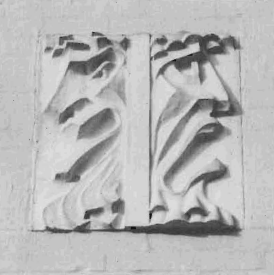
Plaque over the entrance of Raleigh Little Theatre executed by James A. McLean
Dick Reynolds of Winston-Salem later contributed $1,200, which was used to buy teasers and side curtains for the stage, curtains for the orchestra pit, furniture for the lobby, chairs for the workshop and an asbestos curtain for the stage. (Money went a bit farther in those days!)
Providing seats for the auditorium had presented quite a problem to the RLT board and building committee, but Miss Bridgers, the loyal Little Theatre sponsor, and Mrs. Sutton, raised $600 for a down payment and the board worked out arrangements to pay the remainder. Three hundred seats were ordered and installed in time for the first play in October.
Paul Green, the famed Chapel Hill playwright and longtime friend of the Raleigh Little Theatre, contributed the concrete plaque of comedy and tragedy designed and sculpted by area artist James McLean that adorns the front of the building, and shared with RLT a large quantity of surplus Federal Theatre lighting equipment.
Charles Hazell went to Chapel Hill, selected about $3,000 worth of equipment and brought it to the Little Theatre, where the committee restored it and installed it backstage.
Before closing its books and going out of business, the Little Theatre building committee used its last money to buy carpet strips for the aisles of the theatre.
Raleigh Little Theatre’s new home was complete.
Next: Chapter 3. The War Years